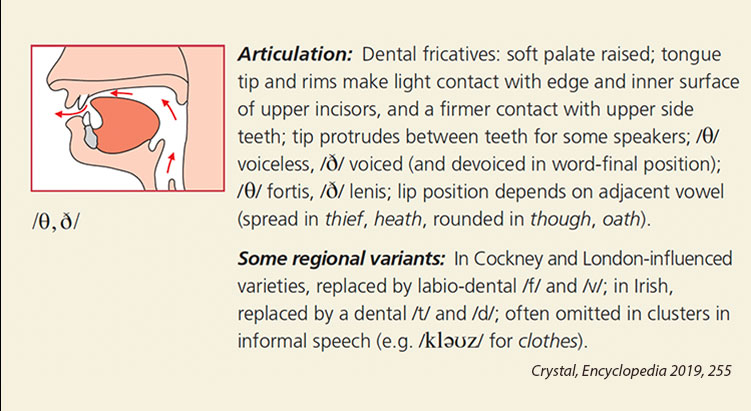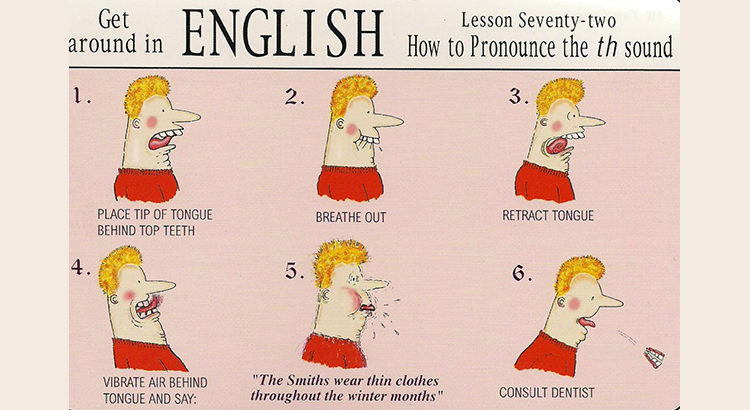“ze mozer of ziz boyz iz tirti-tri”
A standard problem of English pronunciation: the English “th.” With a little help and practice, it actually is not that hard to master.
(Note: For the first more technical article on “th” see my How I Teach the English “th” page.)
Three Ways to Pronounce the “th”
Contrary to what you often read, there are not two but three ways to pronounce the “th.” They are represented by three symbols in the International Phonetic Alphabet used in many handbooks, dictionaries, on the internet, etc.
These three symbols are /t, θ, ð/.
- t: Thames, Thailand, Theresa, Thyme.
- θ: three, lethal, mouth.
- ð: this, mother, breathe.
Be careful with words like lighthouse, lighthearted, etc. Here the “th” comes from joining a word ending in “t” (light) with a word beginning in “h” (house, hearted). This is therefore a different situation. You do not say ligh-thouse but light-house. The same goes for light-hearted.
/t/ as in Tom
This is the easiest one, but it’s not very common in English, which is why it’s not always mentioned. In this case “th” is simply pronounced as a regular English /t/.
There are some regional variations, but this is the way many people say “th” in some proper nouns and a few other words such as Thailand, Thames, Theresa, Thomas, Thyme, Esther.
Beware, not all proper nouns with “th” use the /t/ pronunciation. For example, Théoden, Thatcher, Thea, Thelma use the /θ/ that we will study.
There are no rules to know when “th” is pronounced /t/. You learn this with practice.
/θ/ as in Think, /ð/ as in This
These two ways of saying “th” are almost the same. The main difference is that /ð/ is said with a vibration of the vocal chords, /θ/ without. Don’t worry about how to make the chords vibrate. It happens automatically if you follow the instructions below.
These two consonant sounds are called “fricatives.” To pronounce them you do not close the passage of the air totally like you do for /t,d/ but you let the air go through a small space (friction) between the tongue and the teeth.
Few languages use the /θ-ð/ sounds, which is why many people have a problem with them.
One common issue many people have is they try to say a /t/ when attempting to pronounce these two sounds.
So, how do you make these two fricative sounds? It’s not too difficult, really.
First, if you speak continental Spanish, Arabic or Greek. You’re in luck. You basically have these two sounds or one of them. Continental Spanish has /θ/, from there it is easy to say /ð/. Use the same position and try to say /z/ or imitate the buzzing sound of a bee.
If your first language is French, look at my page on pronouncing the “th” in French.
For the others, place the tip of the tongue close to the top front teeth, without completely blocking the passage of the air. Then, try to say the sounds (not the letters) /s/ as in Sam, or /z/ as in zebra. The muscles of the tongue and the cheeks need to be relaxed. Everything depends on the tongue being close to the teeth without touching them. If you can put the tongue close to the teeth and say /s/ or /z/ you can pronounce /θ-ð/.
Alternatively, you can start from the /t/ sound and just lower the tongue a little bit to let the air go through and try to say /s/ or /z/. As this picture shows and contrary to what is often said, you do not need to stick your tongue out. If you do, just do it a tiny little bit.

There are no rules to decide when to say /θ/ or /ð/. You learn this with practice.
/θ/ as in three
To say the /θ/, place your tongue in the position described above and try to say /s/ as in Sam or to blow air.
For those who speak Spanish, it is basically the same sound as in the Continental Spanish pronunciation of “ción” in words like atención, jubilación, etc. It is also the same sound as in the Arabic thā (ث)
This sound can be found in words
- at the beginning: three, throw, through, thin, thank, think, thief
- in the middle: author, lethal, panther, ethnic, Arthur, nothing,
- at the end: teeth, mouth, breath, bath, heath, death, north, south, worth
/ð/ as in this
The position of the tongue is the same as in /θ/, but you say the sound /z/ (as in zebra, zorro, etc., not the letter z). If you touch your throat while saying this sound, you will feel the vibration of your vocal chords. This is the same sound as the Arabic dhāl (ذ).
Few words use this sound, but they are very common.
This sound can be found in words
- at the beginning: the, this, that, these, those, then, than, thus, there, they, their, them, and in some old words like thou, thee, etc.
- in the middle: weather, mother, leather
- at the end: breathe, bathe
Summary
There are three ways to pronounce the “th” in English.
/t/ is the normal English /t/.
/θ, ð/: the position of the tongue is the same, coming close to the top front teeth but not closing the passage of the air. /θ/ is pronounced without vibration of the vocal chords, /ð/ with vibration.
Don’t try to say a /t/ when saying /θ, ð/.
Be careful too not to say /f/ or /d/. The only sound that should come out is /s/ or /z/, but with the tongue close to the teeth to actually say /θ, ð/.
Often, the best way to quickly improve your pronunciation is through private lessons with a teacher or someone who is trained in language instruction or to pay a coach. It’s a once in a lifetime investment. It’s like riding a bike, you never forget how to do it.
Practically Speaking
There are, of course, many resources available on the internet. My advice: if the instructor tells you to stick your tongue way out, move on to another one. That’s the harder and less efficient way.
Ideally, you should listen to a lot of English. Our brain also learns by imitation. Here are some ideas to help you.
As you do so, try noticing the different pronunciations of the “th.” It’s hard to reproduce sounds that you don’t really hear or are not used to hearing.
If you watch videos in English, look at the speaker’s mouth. Most of the time, you won’t see her tongue.
The goal is not to be good at exercises with individual words but in normal speed speech. Spend time learning to say things in a normal context, not just words or small sentences.
A nice way to learn and practice sounds is, of course, to learn songs, rhymes,poetry, etc.
Some people might need a coach or a speech therapist. That’s ok. It’s not unusual for native English-speaking children to do so too.
Some Exercises
There are many exercises with individual words available (see here for example). But again, I wouldn’t do that too much. You want to be able to say sound in real life contexts, not in isolated words. Also, since a lot of beginners have problems pronouncing the English /r/, practice first with words with no /r/ right after /θ, ð/ (three, through, etc.).
Tongue-Twisters
Tongue twisters are useful as a tongue gymnastics, but, again, go for real life contexts above all.
The baby’s teeth/θ/ will soon teethe /ð/.
Th/ð/e th/θ/ree children bath/ð/e in th/ð/e same bath /θ/.
He th/θ/rew th/θ/ree free th/θ/rows (to practice them with /r/).
Words with a Small Difference
loath – to loathe, sooth – to soothe, teeth – to teethe, cloth – to clothe
thin – tin, thigh – tie, tenth – ten
with – wit, oath – oat
they- day, their, there -dare, those – doze, than – Dan
three – free, thrill – frill
There you go. Now say “The mother of these boys is thirty-three.”
